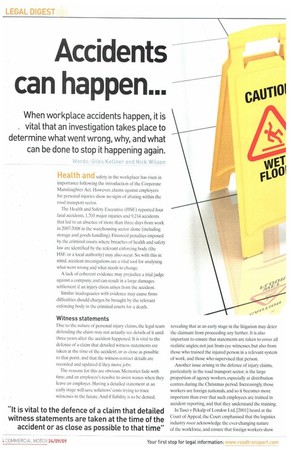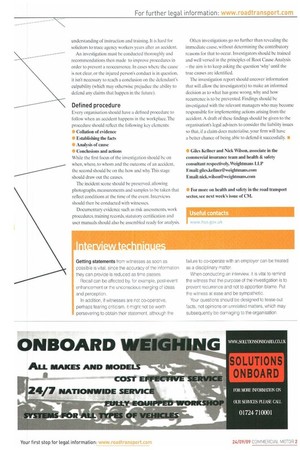Accidents can happen...
Page 24

Page 25

If you've noticed an error in this article please click here to report it so we can fix it.
When workplace accidents happen, it is . vital that an investigation takes place to determine what went wrong, why, and what can be done to stop it happening again.
Words: Giles KetinP, 1'14 klirt" Wihn Health and safety in the workplace has risen in importance following the introduction of the Corporate Manslaughter Act. However, claims against employers for personal injuries show no signs of abating within the road transport sector.
The Health and Safety Executive (HSE) reported four fatal accidents, 1,703 major injuries and 9,214 accidents that led to an absence of more than three days from work in 2007-2008 in the warehousing sector alone (including storage and goods handling). Financial penalties imposed by the criminal courts where breaches of health and safety law are identified by the relevant enforcing body (the HSE or a local authority) may also occur. So, with this in mind, accident investigations are a vital tool for analysing what went wrong and what needs to change.
A lack of coherent evidence may prejudice a trial judge against a company, and can result in a large damages settlement if an injury claim arises from the accident.
Similar inadequacies with evidence may cause firms difficulties should charges be brought by the relevant enforcing body in the criminal courts for a death.
Witness statements
Due to the nature of personal injury claims, the legal team defending the claim may not actually see details of it until three years after the accident happened. It is vital to the defence of a claim that detailed witness statements are taken at the time of the accident, or as close as possible to that point, and that the witness contact details are recorded and updated if they move jobs.
The reasons for this are obvious. Memories fade with time, and an employee's resolve to assist wanes when they leave an employer. Having a detailed statement at an early stage will save solicitors' costs trying to trace witnesses in the future. And if liability is to be denied, revealing that at an early stage in the litigation may deter the claimant from proceeding any further. It is also important to ensure that statements are taken to cover all realistic angles; not just from eye witnesses, but also from those who trained the injured person in a relevant system of work, and those who supervised that person.
Another issue arising in the defence of injury claims, particularly in the road transport sector, is the large proportion of agency workers, especially at distribution centres during the Christmas period. Increasingly, those workers are foreign nationals, and so it becomes more important than ever that such employees are trained in accident reporting, and that they understand the training.
In Tasci v Pckalp of London Ltd, [2001] heard at the Court of Appeal, the Court emphasised that the logistics industry must acknowledge the ever-changing nature of the workforce, and ensure that foreign workers show understanding of instruction and training. It is hard for solicitors to trace agency workers years after an accident.
An investigation must be conducted thoroughly and recommendations then made to improve procedures in order to prevent a reoccurrence. In cases where the cause is not clear, or the injured person's conduct is in question, it isn't necessary to reach a conclusion on the defendant's culpability (which may otherwise prejudice the ability to defend any claims that happen in the future).
Defined procedure
Every organisation should have a defined procedure to follow when an accident happens in the workplace. The procedure should reflect the following key elements: • Collation of evidence • Establishing the facts • Analysis of cause • Conclusions and actions While the first focus of the investigation should be on when, where, to whom and the outcome of an accident, the second should he on the how and why. This stage should draw out the causes The incident scene should be preserved, allowing photographs, measurements and samples to be taken that reflect conditions at the time of the event. Interviews should then be conducted with witnesses.
Documentary evidence such as risk assessments, work procedures, training records, statutory certification and user manuals should also be assembled ready for analysis.
Often investigations go no further than revealing the immediate cause, without determining the contributory reasons for that to occur. Investigators should be trained and well versed in the principles of Root Cause Analysis — the aim is to keep asking the question 'why' until the true causes are identified.
The investigation report should uncover information that will allow the investigator(s) to make an informed decision as to what has gone wrong, why and how recurrence is to be prevented. Findings should be investigated with the relevant managers who may become responsible for implementing actions arising from the accident. A draft of these findings should be given to the organisation's legal advisers to consider the liability issues so that, if a claim dues materialise, your firm will have a better chance of being able to defend it successfully. •
• Giles Kellner and Nick Wilson, associate in the commercial insurance team and health & safety consultant respectively, Weightmans LLP Email: giles.kellner@weightmans.com Email: nick.wilson@weightmans.com • For more on health and safety in the road transport sector, see next week's issue of CM.












































































































































